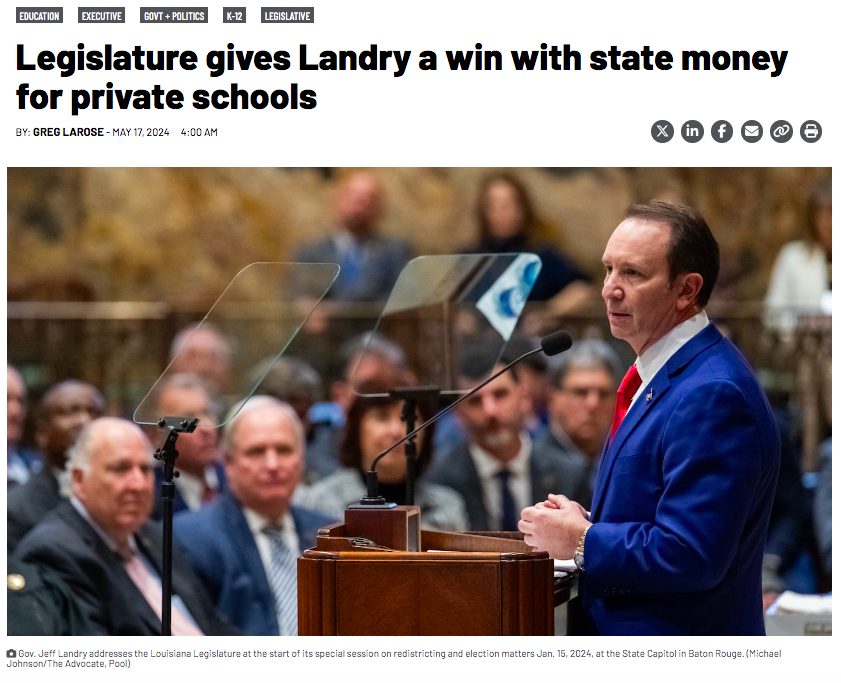
NEW ORLEANS – THE PILOT

New Orleans is the kind of city you go to and feel like you should start a blog. It is just too wonderful not to share, but I digress……..
New Orleans is also the first school district in the country to move to a full charter system.
On a recent trip to New Orleans, I had the opportunity to engage a parent in a conversation about how the post Katrina switch to an almost complete charter school system was going. A summary of this admittedly tangential conversation, while at the New Orleans Jazz Museum, in their words was,“It’s a mess”. She specifically mentioned the inordinate amount of fundraising events and the speed at which she felt charter schools were facilitating segregation via parental involvement.
The Backstory:
The transformation of New Orleans’ public education system began in the aftermath of Hurricane Katrina in 2005. In the wake of the tragedy and an eviscerated tax base, the state of Louisiana took control of the majority of the city’s public schools. Rather than rebuilding the traditional district mode, which were already distressed prior to Katrina, the state embarked on a bold and controversial experiment: the creation of a charter-dominated school system.
An undertaking of this magnitude demanded a new agency and the termination of the 7,000 teachers employed by the district, and so the RSD, The Recovery School District, was born in 2003.
According to the Louisiana State Education Department website,
The Recovery School District (RSD) was created in 2003 by the Louisiana Legislature with the mission of turning around the lowest performing schools in the state.
The RSD is focused on the following school improvement efforts statewide.
– Authorization and oversight of Recovery School District schools, including Type 5 charter schools in East Baton Rouge Parish and Caddo Parish;
– Completing the rebuilding of school facilities in New Orleans through the School Facilities Master Plan (will open in new tab);
-Expanding options and access to quality schools in Baton Rouge through the Baton Rouge Achievement Zone partnership and the development of the centralized enrollment system EnrollBR.
-Partnering with high quality organizations to support the transformation of struggling schools statewide through the School Redesign initiative; and
Acting as the final intervention for schools that continue to struggle despite plans for redesign or comprehensive school system improvement strategies. Involvement by the RSD can include mergers, closures, or transformation by a charter operator.
The rationale behind this shift is fundamentally no different than the arguments we hear today, this one just happened to have at its back, a natural disaster. Supporters argued, as they do now, that the charter model would foster innovation, empower parents, and improve academic improvement through competition. The state also saw an opportunity to break free from the perceived bureaucratic constraints and union influence that had been thought to hinder progress in the past. Sometimes referred to as “administrative burden” “big government “ or “red tape”, depending on who you talk to.
In the decade following Katrina, the number of charter schools in New Orleans quickly proliferated, eventually accounting for nearly all of the city’s public school enrollment. This rapid transition was not without its critics, like today, included people who raised concerns about the loss of community control, the disproportionate impact on marginalized communities, and the potential for profit-driven motives to overshadow the needs of students.
“This was done to us, not with us”
Charter schools showed improvement across a sleuth of typical metrics (report here) but it still is not without its challenges.
The New Orleans school board voted unanimously in February 2024 to open its first non charter public school this upcoming school year.
Why?
There were some aspects of the transition that always seemed to rub community members the wrong way. Pastor Manning said “The charter school program is a failed experiment,” during the school board vote and one time Congressman Cedric Richmond, speaking to the closures, asked how children could have a village if they’re being moved around.
The firing of the largest black teaching workforce in the US in the transition phase speaks to both these sentiments. Many of the teaching staff brought in once all the teachers were laid off came from the usual organizations, like Teach for America, which resulted in the, now commonplace, higher rate of turnover. This coupled with fact that the charter model is known to thrive on, as Gary Sernovitz explains it in his 2018 article in the New Yorker, What New Orleans Tells Us About the Perils of Putting Schools on the Free Market, “many charters work because they devour the time, energy, and bodies of their staff”. A devouring that could never yield the financial rewards that would be necessary to sustain it.
The decision to reopen district schools alongside the existing charter school system marks a pivotal moment. At a minimum it is a recognition that one model is insufficient to address all that ails public education . It is an acknowledgement of the need for a more balanced and inclusive approach while acknowledging the strengths and limitations of the all-charter model implemented in the aftermath of Hurricane Katrina.
While the transition to charters brought improvements in academic performance and graduation rates, concerns over equity, accountability, and community engagement persisted. The reopening of district schools presents an opportunity to address these in addition to fostering a system that offers choice while seeking to ensure access to quality education for all students, regardless of their backgrounds or needs.
Moving forward, the challenge is likely to be an ability to strike the balance between the autonomy of charter schools and the oversight and support provided by the district. Collaboration and open communication between all stakeholders, including parents, educators, and community members, will be essential in shaping an educational landscape that truly serves the diverse needs of New Orleans’ students going forward, a critical element missed from the previous implementation.
The reintroduction of district schools should not be seen as a type of regression, but as a step towards a more comprehensive and thoughtful educational ecosystem.
PLOT TWIST

While this voucher/ESA measure won’t be hammered out until next year, with this action, the city has undoubtedly once again found itself at the forefront of a national conversation on education reform.













